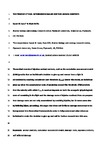The price of attack: Rethinking damage costs in animal contests
| dc.contributor.author | Lane, SM | |
| dc.contributor.author | Briffa, M | |
| dc.date.accessioned | 2017-02-27T09:28:41Z | |
| dc.date.available | 2017-02-27T09:28:41Z | |
| dc.date.issued | 2017-04-01 | |
| dc.identifier.issn | 0003-3472 | |
| dc.identifier.issn | 1095-8282 | |
| dc.identifier.uri | http://hdl.handle.net/10026.1/8565 | |
| dc.description.abstract |
Theoretical models of injurious animal contests, such as the cumulative assessment model (CAM), predict that an individual's decision to give up and retreat from a fight is determined by reaching a maximum cost threshold (Cmax). Under this model, an individual gives up when the accumulated costs of persisting exceed this threshold. CAM predicts that the velocity with which Cmax is reached depends on both the energetic (physiological) costs of remaining in the fight and the damage costs of injuries received. Here we propose that damage costs are accumulated not only by receiving injuries, but in some cases also by inflicting injury (attacking). We argue that these self-inflicted damage costs need to be incorporated into theoretical frameworks to fully understand what drives an individual to make the decision to give up, and we call for further research into this area. | |
| dc.format.extent | 23-29 | |
| dc.language | en | |
| dc.language.iso | en | |
| dc.publisher | Elsevier BV | |
| dc.subject | animal contests | |
| dc.subject | cumulative assessment model | |
| dc.subject | damage costs | |
| dc.subject | injurious contests | |
| dc.subject | self-inflicted damage | |
| dc.title | The price of attack: Rethinking damage costs in animal contests | |
| dc.type | journal-article | |
| dc.type | Article | |
| plymouth.author-url | https://www.webofscience.com/api/gateway?GWVersion=2&SrcApp=PARTNER_APP&SrcAuth=LinksAMR&KeyUT=WOS:000400402700004&DestLinkType=FullRecord&DestApp=ALL_WOS&UsrCustomerID=11bb513d99f797142bcfeffcc58ea008 | |
| plymouth.volume | 126 | |
| plymouth.publication-status | Published | |
| plymouth.journal | Animal Behaviour | |
| dc.identifier.doi | 10.1016/j.anbehav.2017.01.015 | |
| plymouth.organisational-group | /Plymouth | |
| plymouth.organisational-group | /Plymouth/Faculty of Science and Engineering | |
| plymouth.organisational-group | /Plymouth/Faculty of Science and Engineering/School of Biological and Marine Sciences | |
| plymouth.organisational-group | /Plymouth/REF 2021 Researchers by UoA | |
| plymouth.organisational-group | /Plymouth/REF 2021 Researchers by UoA/UoA04 Psychology, Psychiatry and Neuroscience | |
| plymouth.organisational-group | /Plymouth/Research Groups | |
| plymouth.organisational-group | /Plymouth/Research Groups/Marine Institute | |
| plymouth.organisational-group | /Plymouth/Users by role | |
| plymouth.organisational-group | /Plymouth/Users by role/Academics | |
| plymouth.organisational-group | /Plymouth/Users by role/Researchers in ResearchFish submission | |
| dcterms.dateAccepted | 2017-01-19 | |
| dc.rights.embargodate | 2018-2-24 | |
| dc.identifier.eissn | 1095-8282 | |
| dc.rights.embargoperiod | 12 months | |
| rioxxterms.versionofrecord | 10.1016/j.anbehav.2017.01.015 | |
| rioxxterms.licenseref.uri | http://www.rioxx.net/licenses/under-embargo-all-rights-reserved | |
| rioxxterms.licenseref.startdate | 2017-04-01 | |
| rioxxterms.type | Journal Article/Review | |
| plymouth.funder | The role of additive and non-additive genetic effects during animal contests in the beadlet sea anemone Actinia equina::BBSRC |


